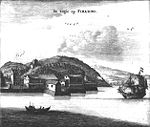- VOC Opperhoofden in Japan
-
Main article: Dutch East India Company
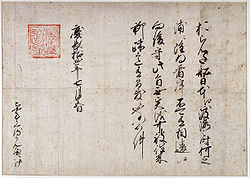 The "trade pass" (Dutch: handelspas) issued in the name of Tokugawa Ieyasu. The text commands: "Dutch ships are allowed to travel to Japan, and they can disembark on any coast, without any reserve. From now on this regulation must be observed, and the Dutch left free to sail where they want throughout Japan. No offenses to them will be allowed, such as on previous occasions" – dated August 24, 1609 (Keichō 14, 25th day of the 6th month); n.b., the goshuin (御朱印) identifies this as an official document bearing the shogun's scarlet seal.
The "trade pass" (Dutch: handelspas) issued in the name of Tokugawa Ieyasu. The text commands: "Dutch ships are allowed to travel to Japan, and they can disembark on any coast, without any reserve. From now on this regulation must be observed, and the Dutch left free to sail where they want throughout Japan. No offenses to them will be allowed, such as on previous occasions" – dated August 24, 1609 (Keichō 14, 25th day of the 6th month); n.b., the goshuin (御朱印) identifies this as an official document bearing the shogun's scarlet seal.
VOC Opperhoofden in Japan were the chief traders of the Dutch East India Company (Vereenigde Oostindische Compagnie or VOC in old-spelling Dutch, literally "United East Indian Company") in Japan during the period of the Tokugawa shogunate, also known as the Edo period.
Opperhoofd is a Dutch word (plural Opperhoofden) which literally means 'supreme head[man]'. In its historical usage, the word is a gubernatorial title, comparable to the English chief factor, for the chief executive officer of a Dutch factory in the sense of trading post, as led by a factor, i.e. agent.
The Dutch East India Company was established in 1602 by the States-General of the Netherlands to carry out colonial activities in Asia. The VOC enjoyed unique success in Japan, in part because of the ways in which the character and other qualities of its Opperhoofden were perceived to differ from other competitors.
Contents
Trading posts or factories
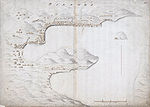 Topographical map of the bay of Hirado in 1621. To the right on the shore-line, the Dutch East India Company trading post is marked with the red-white-blue flag of the Netherlands. To the far left, somewhat back from the shore-line, notice the white flag with the red cross, the St George's Cross of England at the East India Company trading post -- drawing, 1621.
Topographical map of the bay of Hirado in 1621. To the right on the shore-line, the Dutch East India Company trading post is marked with the red-white-blue flag of the Netherlands. To the far left, somewhat back from the shore-line, notice the white flag with the red cross, the St George's Cross of England at the East India Company trading post -- drawing, 1621.
Hirado, 1609-1639
The first VOC trading outpost in Japan was on the island of Hirado off the coast of Kyūshū. Permission for establishing this permanent facility was granted in 1609; but the right to make use of this convenient location was revoked in 1639.
Dejima, 1639-1860
In 1638, the harsh Sakoku ("closed door" policy) was ordered by the Tokugawa shogunate; and by 1641, the VOC had to transfer all of its mercantile operations to the small man-made island of Dejima in Nagasaki harbor. The island had been built for the Portuguese, but they had been forced to abandon it and all contacts with Japan. Only the Dutch were permitted to remain after all other Westerners had been excluded.
The Dutch presence in Japan was closely monitored and controlled. For example, each year the VOC had to transfer the opperhoofd. Each opperhoofd was expected to travel to Edo to offer tribute to the shogun. The VOC traders had to be careful not to import anything religious; and they were not allowed to bring any females, nor to bury their dead ashore. They were largely free to do as they pleased on the island; but they were explicitly ordered to work on Sunday.
For nearly 250 years a series of VOC traders lived, worked and seemed to thrive in this confined location.
List of chief traders at Hirado
Main article: HiradoHirado (平戸市 today known as Hirado-shi) is a small island just off the western shore of the Japanese island of Kyūshū. In the early 17th century, Hirado was a major center of foreign trade and included British, Chinese, and other trading stations along with the Dutch one, maintained and operated by the VOC after 1609. The serial leaders of this VOC trading enclave or "factory" at Hirado were:
- Jacques Specx: 20.9.1609 - 28.8.1612
- Hendrick Brouwer: 28.8.1612 - 6.8.1614
- Jacques Specx: 6.8.1614 - 29.10.1621
- Leonardt Camps: 29.10.1621 - 21.11.1623
- Cornelis van Nijenroode: 21.11.1623 - _._.1631
- Pieter Stamper: 1631
- Cornelis van Nijenrode: _._.1631 - 31.1.1633
- Pieter van Sante or Pieter van Santen: 31.1.1633 - 6.9.1633
- Nicolaes Couckebacker: 6.9.1633 - _._.1635
- Maerten Wesselingh or Hendrick Hagenaer (?): _._.1635-_._.1637
- Nicolaes Couckebacker: _._.1637 - 3.2.1639
- François Caron: 3.2.1639 - 13.2.1641 Caron was last Opperhoofd at Hirado.[1]
List of chief traders at Dejima
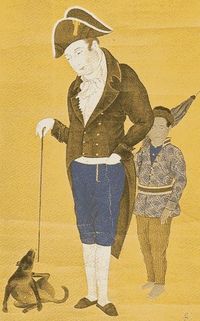 Hendrik Doeff and a Balinese servant in Dejima, Japanese painting.
Hendrik Doeff and a Balinese servant in Dejima, Japanese painting.
Dejima (出島) was a fan-shaped artificial island in the bay of Nagasaki. This island was a Dutch trading post during Japan's period of maritime restrictions (海禁, kaikin, 1641–1853) during the Edo period. The serial leaders of this VOC trading enclave or "factory" at Dejima were:
- Maximiliaen Le Maire: 14.2.1641 - 30.10.1641 Le Maire was the first "new" chief trader at Dejima[1]
- Jan van Elseracq: 1.11.1641 - 29.10.1642
- Pieter Anthonijszoon Overtwater: 29.10.1642 - 1.8.1643
- Jan van Elserac: 1.8.1643 - 24.11.1644
- Pieter Anthonijszoon Overtwater: 24.11.1644 - 30.11.1645
- Reinier van Tzum: 30.11.1645 - 27.10.1646
- Willem Verstegen [Versteijen]: 28.10.164 - 10.10.1647
- Frederick Coijet: 3.11.1647 - 9.12.1648
- Dircq Snoecq: 9.12.1648 - 5.11.1649
- Anthonio van Brouckhorst: 5.11.1649 - 25.10.1650
- Pieter Sterthemius: 25.10.1650 - 3.11.1651
- Adriaen van der Burgh: 1.11.1651 - 3.11.1652
- Frederick Coijet: 4.11.1652 - 10.11.1653
- Gabriel Happart: 4.11.1653 - 31.10.1654
- Leonard Winninx: 31.10.1654 - 23.10.1655
- Joan Boucheljon: 23.10.1655 - 1.11.1656
- Zacharias Wagenaer [Wagener]: 1.11.1656 - 27.10.1657
- Joan Boucheljon: 27.10.1657 - 23.10.1658
- Zacharias Wagenaer [Wagener]: 22.10.1658 - 4.11.1659
- Joan Boucheljon: 4.11.1659 - 26.10.1660
- Hendrick Indijck: 26.10.1660 - 21.11.1661
- Dirck van Lier: 11.11.1661 - 6.11.1662
- Hendrick Indijck: 6.11.1662 - 20.10.1663
- Willem Volger: 20.10.1663 - 7.11.1664
- Jacob Gruijs: 7.11.1664 - 27.10.1665
- Willem Volger: 28.10.1665: - 27.10.1666
- Daniel Six: 18.10.1666 - 6.11.1667
- Constantin Ranst de Jonge: 6.11.1667 - 25.10.1668
- Daniel Six [Sicx]: 25.10.1668 - 14.10.1669
- François de Haze: 14.10.1669 - 2.11.1670
- Martinus Caesar: 2.11.1670 - 12.11.1671
- Johannes Camphuys: 22.10.1671 - 12.11.1672[2]
- Martinus Caesar: 13.11.1672 - 29.10.1673
- Johannes Camphuys: 29.10.1673 - 19.10.1674[2]
- Martinus Caesar: 20.10.1674 - 7.11.1675
- Johannes Camphuys: 7.11.1675 - 27.10.1676[2]
- Dirck de Haze: 27.10.1676 - 16.10.1677
- Albert Brevincq: 16.10.1677 - 4.11.1678
- Dirck de Haas: 4.11.1678 - 24.10.1679
- Albert Brevincq: 24.10.1679 - 11.11.1680
- Isaac van Schinne: 11.11.1680 - 31.10.1681
- Hendrick Canzius: 31.10.1681 - 20.10.1682
- Andreas Cleyer: 20.10.1682 - 8.11.1683[2]
- Constantin Ranst de Jonge: 8.11.1683 - 28.10.1684
- Hendrick van Buijtenhem: 25.10.1684 - 7.10.1685[3]
- Andreas Cleyer: 17.10.1685 - 5.11.1686[2]
- Constantin Ranst de Jonge: 5.11.1686 - 25.10.1687
- Hendrick van Buijtenhem: 25.10.1687 - 13.10.1688[3]
- Cornelis van Outhoorn: 13.10.1688 - 1.11.1689
- Balthasar Sweers: 1.11.1689 - 21.10.1690
- Hendrick van Buijtenhem: 21.10.1690 - 09.11.1691[3]
- Cornelis van Outhoorn: 9.11.1691 - 29.10.1692
- Hendrick van Buijtenhem: 29.10.1692 - 19.10.1693[3]
- Gerrit de Heere: 19.10.1693: - 7.11.1694
- Hendrik Dijkman: 7.11.1694 - 27.10.1695
- Cornelis van Outhoorn: 27.10.1695 - 15.10.1696
- Hendrik Dijkman: 15.10.1696 - 3.11.1697
- Pieter de Vos: 3.11.1697 - 23.10.1698
- Hendrik Dijkman: 23.10.1698 - 12.10.1699
- Pieter de Vos: 21.10.1699 - 31.10.1700
- Hendrik Dijkman: 31.10.1700 - 21.10.1701
- Abraham Douglas: 21.10.1701 - 30.10.1702
- Ferdinand de Groot: 9.11.1702 - 30.10.1703
- Gideon Tant: 30.10.1703 - 18.10.1704
- Ferdinand de Groot: 18.10.1704 - 6.11.1705
- Ferdinand de Groot: 26.10.1706 - 15.10.1707
- Hermanus Menssingh: 15.10.1707 - 2.11.1708
- Jasper van Mansdale: 2.11.1708 - 22.10.1709
- Hermanus Menssingh: 22.10.1709 - 10.11.1710
- Nicolaas Joan van Hoorn: 10.11.1710 - 31.10.1711
- Cornelis Lardijn: 31.10.1711 - 7.11.1713
- Cornelis Lardijn: 7.11.1713 - 27.10.1714
- Nicolaas Joan van Hoorn: 27.10.1714 -19.10.1715
- Gideon Boudaen: 19.10.1715 - 3.11.1716
- Joan Aouwer: 3.11.1716 - 24.10.1717
- Christiaen van Vrijbergh[e]: 24.10.1717 - 13.10.1718
- Joan Aouwer: 13.10.1718 - 21.10.1720
- Roeloff Diodati: 21.10.1720 - 9.11.1721
- Hendrik Durven: 9.11.1721 - 18.10.1723
- Johannes Thedens: 18.10.1723 - 25.10.1725
- Joan de Hartogh: 25.10.1725 - 15.10.1726
- Pieter Boockestijn: 15.10.1726 - 3.11.1727
- Abraham Minnedonk: 3.11.1727 - 20.10.1728
- Pieter Boockestijn: 22.10.1728 - 12.10.1729
- Abraham Minnedonk: 12.10.1729 - 31.10.1730
- Pieter Boockestijn: 31.10.1730 - 7.11.1732
- Hendrik van de Bel: 7.11.1732 - 27.10.1733
- Rogier de Laver: 27.10.1733 - 16.10.1734
- David Drinckman: 16.10.1734 - 4.11.1735
- Bernardus Coop [Coopa] à Groen: 4.11.1735 - 24.10.1736
- Jan van der Cruijsse: 24.10.1736 - 13.10.1737
- Gerardus Bernardus Visscher: 13.10.1737 - 21.10.1739
- Thomas van Rhee: 22.10.1739 - 8.11.1740
- Jacob van der Waeijen: 9.11.1740 - 28.10.1741
- Thomas van Rhee: 29.10.1741 - 17.10.1742
- Jacob van der Waeijen: 17.10.1742 - 9.11.1743
- David Brouwer: 5.11.1743 - 1.11.1744
- Jacob van der Waeijen: 2.11.1744 - 28.12.1745
- Jan Louis de Win: 30.12.1745 - 2.11.1746
- Jacob Baelde: 3.11.1746 - 25.10.1747
- Jan Louis de Win: 28.10.1747 - 11.11.1748
- Jacob Baelde: 12.11.1748 - 8.12.1749
- Hendrik van Homoed: 8.12.1749 - 24.12.1750
- Abraham van Suchtelen: 25.12.1750 - 18.11.1751
- Hendrik van Homoed: 19.11.1751 - 5.12.1752
- David Boelen: 6.12.1752 - 15.10.1753
- Hendrik van Homoed: 16.10.1753 - 3.11.1754
- David Boelen: 4.11.1754 - 25.10.1755
- Herbert Vermeulen: 25.10.1755 - 12.10.1756
- David Boelen: 13.10.1756 - 31.10.1757
- Herbert Vermeulen: 1.11.1757 - 11.11.1758
- Johannes Reijnouts: 12.11.1758 - 11.11.1760
- Marten Huijshoorn: 12.11.1760 - 30.10.1761
- Johannes Reijnouts: 31.10.1761 - 2.12.1762
- Fredrik Willem Wineke: 3.12.1762 - 6.11.1763
- Jan Crans: 7.11.1763 - 24.10.1764
- Fredrik Willem Wineke: 25.10.1764 - 7.11.1765
- Jan Crans: 8.11.1765 - 31.10.1766
- Herman Christiaan Kastens: 1.11.1766 - 20.10.1767
- Jan Crans: 21.10.1767 - 8.11.1769
- Olphert Elias: 9.11.1769 - 16.11.1770
- Daniel Armenault: 17.11.1770 - 9.11.1771
- Arend Willem Feith: 10.11.1771 - 3.11.1772
- Daniel Armenault [Almenaault]: 4.11.1772 - 22.11.1773
- Arend Willem Feith: 23.11.1773 - 10.11.1774
- Daniel Armenault [Almenaault]: 11.11.1774 - 28.10.1775
- Arend Willem Feith: 28.10.1775 - 22.11.1776
- Hendrik Godfried Duurkoop: 23.11.1776 - 11.11.1777
- Arend Willem Feith: 12.11.1777 - 28.11.1779
- Isaac Titsingh: 29.11.1779 - 5.11.1780
- Arend Willem Feith: 6.11.1780 - 23.11.1781
- Isaac Titsingh: 24.11.1781 - 26.10.1783
- Hendrik Caspar Romberg: 27.10.1783 - _.8.1784
- Isaac Titsingh: _.8.1784 - 30.11.1784
- Hendrik Caspar Romberg: 0.11.84 - 21.11.1785
- Johan Fredrik van Rheede tot de Parkeler: 22.11.1785 - 20.11.1786
- Hendrik Caspar Romberg: 21.11.1786 - 30.11.1787
- Johan Frederik van Rheede tot de Parkeler: 1.12.1787 - 1.8.1789
- Hendrik Casper Romberg: 1.8.1789 - 13.11.1790
- Petrus Theodorus Chassé: 13.11.1790 - 13.11.1792
- Gijsbert Hemmij: 13.11.1792 - 8.7.1798
- Leopold Willem Ras: 8.7.1798 - 17.7.1800
- Willem Wardenaar: 16.7.1800 - 14.11.1803
- Hendrik Doeff: 14.11.1803 - 6.12.1817
- Jan Cock Blomhoff: 6.12.1817 - 20.11.1823
- Johan Willem de Sturler: 20.11.1823 - 5.8.1826
- Germain Felix Meijlan: 4.8.1826 - 1.11.1830
- Jan Willem Fredrik van Citters: 1.11.1830 - 30.11.1834
- Johannes Erdewin Niemann: 1.12.1834 - 17.11.1838
- Eduard Grandisson: 18.11.1838 - _.11.1842
- Pieter Albert Bik: _.11.1842 - 31.10.1845
- Joseph Henrij Levijssohn: 1.11.1845 - 31.10.1850
- Frederick Colnelis Rose: 1.11.1850 - 31.10.1852
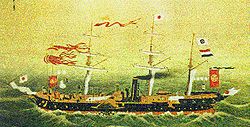 The last of the Dejima-based Opperhoofden handled the 1855 delivery of the Kankō Maru (観光丸), Japan's first modern steam warship -- a gift from the Dutch King Willem III of the Netherlands to the Tokugawa Shogunate
The last of the Dejima-based Opperhoofden handled the 1855 delivery of the Kankō Maru (観光丸), Japan's first modern steam warship -- a gift from the Dutch King Willem III of the Netherlands to the Tokugawa Shogunate
- Janus Henricus Donker Curtius: 2.11.1852 - 28.2.1860 [Donker Curtius became the last in a long list of hardy Dutch Opperhoofden who were stationed at Dejima; and fortuitously, Curtius also became the first of many Dutch diplomatic and trade representatives in Japan during the burgeoning pre-Meiji years.]
References
- ^ a b Dejima opperhoofden chronology; Caron chronology (German); Boxer, Charles Ralph, ed. (1935). A True Description of the Mighty Kingdoms of Japan & Siam, p. LXII.
- ^ a b c d e Kornicki, Peter F. "European Japanology at the End of the Seventeenth Century," Bulletin of School of Oriental and African Studies, University of London. Vol. 56, No. 3 (1993). pp. 510.
- ^ a b c d Kornicki, p. 507.
Sources
- Blomhoff, J.C. (2000). The Court Journey to the Shogun of Japan: From a Private Account by Jan Cock Blomhoff. Amsterdam
- Blussé, L. et al., eds. (1995–2001) The Deshima [sic] Dagregisters: Their Original Tables of Content. Leiden.
- Blussé, L. et al., eds. (2004). The Deshima Diaries Marginalia 1740-1800. Tokyo.
- Boxer. C.R. (1950). Jan Compagnie in Japan, 1600-1850: An Essay on the Cultural, Aristic, and Scientific Influence Exercised by the Hollanders in Japan from the Seventeenth to the Nineteenth Centuries. Den Haag.
- Caron, F. (1671). A True Description of the Mighty Kingdoms of Japan and Siam. London.
- (Dutch) de Winter, Michiel. (2006). "VOC in Japan: Betrekkingen tussen Hollanders en Japanners in de Edo-periode, tussen 1602-1795" ("VOC in Japan: Relations between the Dutch and Japanese in the Edo-period, between 1602-1795").
- Doeff, H. (1633). Herinneringen uit Japan. Amsterdam. [Doeff, H. "Recollections of Japan" ISBN 1-55395-849-7]
- Edo-Tokyo Museum exhibition catalog. (2000). A Very Unique Collection of Historical Significance: The Kapitan (the Dutch Chief) Collection from the Edo Period—The Dutch Fascination with Japan. Catalog of "400th Anniversary Exhibition Regarding Relations between Japan and the Netherlands," a joint project of the Edo-Tokyo Museum, the City of Nagasaki, the National Museum of Ethnology, the National Natuurhistorisch Museum" and the National Herbarium of the Netherlands in Leiden, the Netherlands. Tokyo.
- Leguin, F. (2002). Isaac Titsingh (1745-1812): Een passie voor Japan, leven en werk van de grondlegger van de Europese Japanologie. Leiden.
- Nederland's Patriciaat, Vol. 13 (1923). Den Haag.
- Screech, Timon. (2006). Secret Memoirs of the Shoguns: Isaac Titsingh and Japan, 1779-1822. London.
- Siebold, P.F.v. (1897). Nippon. Würzburg e Leipzig.
- Titsingh, I. (1820). Mémoires et Anecdotes sur la Dynastie régnante des Djogouns, Souverains du Japon. Paris.
- Titsingh, I. (1822). Illustrations of Japan; consisting of Private Memoirs and Anecdotes of the reigning dynasty of The Djogouns, or Sovereigns of Japan. London.
See also
- Dutch missions to Edo
- Rangaku - Dutch studies
Sources and external links
- Original list of opperhoofden (in Dutch)
- Dejima: The Island Comes Back to Life
- A map of Deshima
- At the bottom you will also find an image of Deshima
- WorldStatesmen - Japan
Coordinates: 32°44′37″N 129°52′23″E / 32.743525°N 129.873022°E
Links to related articles Portuguese Empire North Africa15th century
1415–1640 Ceuta
1458–1550 Alcácer Ceguer (El Qsar es Seghir)
1471–1550 Arzila (Asilah)
1471–1662 Tangier
1485–1550 Mazagan (El Jadida)
1487– middle 16th century Ouadane
1488–1541 Safim (Safi)
1489 Graciosa16th century
1505–1769 Santa Cruz do Cabo
de Gué (Agadir)
1506–1525 Mogador (Essaouira)
1506–1525 Aguz (Souira Guedima)
1506–1769 Mazagan (El Jadida)
1513–1541 Azamor (Azemmour)
1515 São João da Mamora (Mehdya)
1577–1589 Arzila (Asilah)Sub-Saharan Africa15th century
1455–1633 Arguin
1470–1975 Portuguese São Tomé1
1474–1778 Annobón
1478–1778 Fernando Poo (Bioko)
1482–1637 Elmina (São Jorge
da Mina)
1482–1642 Portuguese Gold Coast
1496–1550 Portuguese Madagascar
1498–1540 Mascarene Islands16th century
1500–1630 Malindi
1500–1975 Portuguese Príncipe1
1501–1975 Portuguese E. Africa
(Mozambique)
1502–1659 Portuguese Saint Helena
1503–1698 Zanzibar
1505–1512 Quíloa (Kilwa)
1506–1511 Socotra
1557–1578 Portuguese Accra
1575–1975 Portuguese W. Africa
(Angola)
1588–1974 Cacheu2
1593–1698 Mombassa (Mombasa)17th century
1642–1975 Portuguese Cape Verde
1645–1888 Ziguinchor
1680–1961 São João Baptista de Ajudá
1687–1974 Portuguese Bissau2
18th century
1728–1729 Mombassa (Mombasa)
1753–1975 Portuguese São Tomé and Príncipe
19th century
1879–1974 Portuguese Guinea
1885–1975 Portuguese Congo1 Part of São Tomé and Príncipe from 1753. 2 Part of Portuguese Guinea from 1879. Southwest Asia16th century
1506–1615 Gamru (Bandar-Abbas)
1507–1643 Sohar
1515–1622 Hormuz (Ormus)
1515–1648 Quriyat
1515–? Qalhat
1515–1650 Muscat
1515?–? Barka
1515–1633? Julfar (Ras al-Khaimah)
1521–1602 Bahrain (Muharraq and Manama)
1521–1529? Qatif
1521?–1551? Tarut Island
1550–1551 Qatif
1588–1648 Matrah17th century
1620–? Khor Fakkan
1621?–? As Sib
1621–1622 Qeshm
1623–? Khasab
1623–? Libedia
1624–? Kalba
1624–? Madha
1624–1648 Dibba Al-Hisn
1624?–? Bandar-e KongIndian subcontinent15th century
1498–1545 Laccadive Islands
(Lakshadweep)16th century
Portuguese India
· 1500–1663 Cochim (Kochi)
· 1502–1661 Quilon (Coulão/Kollam)
· 1502–1663 Cannanore (Kannur)
· 1507–1657 Negapatam (Nagapatnam)
· 1510–1962 Goa
· 1512–1525 Calicut (Kozhikode)
· 1518–1619 Portuguese Paliacate trading outpost (Pulicat)
· 1521–1740 Chaul
· 1523–1662 Mylapore
· 1528–1666 Chittagong
· 1531–1571 Chaul
· 1534–1601 Salsette Island
· 1534–1661 Bombay (Mumbai)
· 1535–1739 Baçaím (Vasai-Virar)
· 1536–1662 Cranganore (Kodungallur)
· 1540–1612 Surat
· 1548–1658 Tuticorin (Thoothukudi)16th century (continued)
Portuguese India (continued)
· 1559–1962 Daman and Diu
· 1568–1659 Mangalore
· 1579–1632 Hugli
· 1598–1610 Masulipatnam (Machilipatnam)
1518–1521 Maldives
1518–1658 Portuguese Ceylon (Sri Lanka)
1558–1573 Maldives
17th century
Portuguese India
· 1687–1749 Mylapore
18th century
Portuguese India
· 1779–1954 Dadra and Nagar HaveliEast Asia and Oceania16th century
1511–1641 Portuguese Malacca
1512–1621 Portuguese Maluku Islands
· 1522–1575 Ternate
· 1576–1605 Ambon
· 1578–1650 Tidore
1512–1665 Makassar
1553–1999 Portuguese Macau
1571–1639 Decima (Dejima, Nagasaki)17th century
1642–1975 Portuguese Timor (East Timor)1
19th century
Portuguese Macau
· 1864–1999 Coloane
· 1849–1999 Portas do Cerco
· 1851–1999 Taipa
· 1890–1999 Ilha Verde
20th century
Portuguese Macau
· 1938–1941 Lapa and Montanha (Hengqin)1 1975 is the year of East Timor's Declaration of Independence and subsequent invasion by Indonesia. In 2002, East Timor's independence was recognized by Portugal & the world.
North America and the North Atlantic Ocean16th century
1500–1579? Terra Nova (Newfoundland)
1500–1579? Labrador
1516–1579? Nova ScotiaCentral and South America16th century
1500–1822 Brazil
1536–1620 Portuguese Barbados17th century
1680–1777 Nova Colónia do Sacramento
19th century
1808–1822 Cisplatina (Uruguay)
1809–1817 Portuguese Guiana
1822 Upper PeruDutch Empire Colonies and trading posts of the Dutch East India Company (1602-1798) GovernoratesAmbon · Banda · Batavia · Cape Colony · Ceylon · Coromandel · Formosa · Northeast coast of Java · Makassar · Malacca · MoluccasDirectoratesCommandmentsResidenciesSettlements with an opperhoofdColonies and trading posts of the Dutch West India Company (1621-1792) Colonies in the AmericasAcadia · Berbice† · Cayenne · Curaçao and Dependencies · Demerara · Essequibo · Brazil · New Netherland · Pomeroon · Sint Eustatius and Dependencies · Suriname‡ · Tobago · Virgin IslandsTrading posts in Africa† Governed by the Society of Berbice · ‡ Governed by the Society of SurinameSettlements of the Noordsche Compagnie (1614-1642) SettlementsColonies of the Kingdom of the Netherlands (1815-1962) Until 1825Until 1853Until 1872Until 1945Until 1954Until 1962† Became constituent countries of the Kingdom of the Netherlands; Suriname gained full independence in 1975, Curaçao and Dependencies was renamed to the Netherlands Antilles, which was eventually dissolved in 2010.Kingdom of the Netherlands (1954-Present) Constituent countriesPublic bodies of the NetherlandsCategories:- Dutch East India Company
- Artificial islands
- Edo period
Wikimedia Foundation. 2010.


